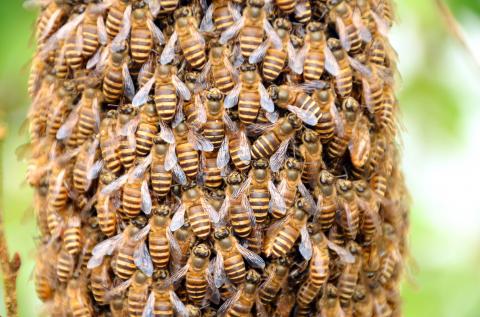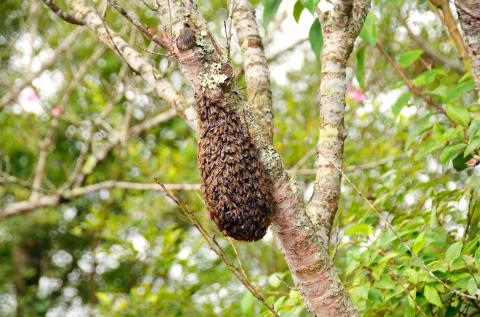Over a thousand honeybees forming an elliptical shape as they gather on a cherry tree instead of staying in a beehive was something that farm owner Tsai Cheng-ming had never seen in the several decades that he has lived on Jinjhen Mountain in Taitung County’s Taimali Township. After observing the bees for nearly two hours, the following day when he went back the bees were nowhere to be found. Tsai Nu-jen, head of Taitung District Agricultural Research and Extension Station’s Department of Crop Environment, says that this is a natural swarming phenomenon among China’s wild honeybees, typically occurring in the spring. It means that the local ecological environment is doing well, he says.
Tsai Cheng-ming, owner of Chingshan Farm on Jinjhen Mountain, says that on the morning of Feb. 23 when he was cleaning up his farm he came across a ball-shaped object on a tree by the side of the road. After walking closer to it, he discovered that it was a swarm of over a thousand bees. The “ball of bees” was squirming around on the 3m-tall cherry tree, approximately 1.5 from the ground, Tsai says, adding that the elliptical shape was about 20cm in diameter.
Tsai Nu-jen says that this particular swarm of honeybees from China was in the middle of swarming. Once a group of honeybees grows large and strong enough, it produces a new queen, he says, adding that the old queen leaves the colony and takes a swarm of bees with her, which gathers on a tree until the swarm is complete. Then it prepares to move to a suitable location to make a new colony, while the old colony is left to the new queen bee. The phenomenon of swarming is most commonly seen in the spring, particularly among wild Chinese honeybees. The so-called ball of bees is only a temporary gathering — a natural phenomenon that should not alarm people. Swarming means that a group of honeybees is gradually getting stronger. Seeing a group of bees swarming in the wild is good news, especially in recent years with increasing numbers of bee colonies disappearing.
(Liberty Times, Translated by Kyle Jeffcoat)

Photo: Wang Hsiu-ting, Liberty Times
照片:自由時報記者王秀亭
上千隻蜜蜂沒在蜂窩裡,卻是聚集在櫻花樹上,形成一團橢圓形蜂球,台東太麻里鄉農園主人蔡政銘說,在金針山生活三、四十年,首見這種情形,觀察了將近兩小時,隔日再看已不見蹤影,台東農業改良場作物環境課長蔡恕仁表示,這是中國野蜂分巢的自然現象,多發生在春天,顯示當地自然生態良好。
金針山青山農園主人蔡政銘表示,二月廿三日上午整理園裡環境時,發現路邊的櫻花樹上有一團球狀物體,走近一看竟是上千隻蜜蜂聚集在一起,「蜂球」附著三公尺高的櫻花樹上蠕動著,離地約一點五公尺,是個長約二十公分的橢圓形球體。
蔡恕仁表示,此一蜂群是中國野蜂正在分巢,每當蜜蜂族群壯大到一定程度,產生新的蜂后時,舊蜂后即會帶走一群蜜蜂,到樹上集結,待集結完成,便準備到下一個適合做巢地點,準備做下一個巢,舊巢就留給新的蜂后;分巢現象常見於春天,特別是中國野蜂,樹上的蜂球只是短暫集結,為一自然現象,民眾不必太過恐慌,分巢顯示蜂群逐漸壯大,特別是近年來蜂群消失時有所聞,野外蜂群有分巢是個好消息。
(自由時報記者王秀亭)

Photo: Wang Hsiu-ting, Liberty Times
照片:自由時報記者王秀亭

A: According to reporter Joon Lee’s analysis, what are other reasons why the Los Angeles Dodgers made back baseball superstar Shohei Ohtani’s huge contract so quickly? B: Second, a lot of Japanese and global enterprises are eager to benefit from the “Ohtani effect”. . . A: That’s sure to increase the Dodgers’ bargaining chips in negotiations. B: Lastly, all this media coverage is elevating the Dodgers’ brand to a new level, boosting the value of the franchise. A: I can’t wait to see a battle between Ohtani and “Team Taiwan” at the 2026 World Baseball Classic. A: 根據記者Joon Lee的分析,洛杉磯道奇隊和球星大谷翔平的巨約快速回本還有哪些原因? B: 第二、無數日本和全球企業都想和這股「大谷效應」沾上邊……。 A: 這也增加了道奇在各種商業談判中的籌碼吧。 B: 第三、媒體報導更將道奇的品牌形象推升至全新的高度,使該隊價值水漲船高。 A: 真期待在2026年「世界棒球經典賽」,看到大谷和台灣隊的經典對決! (By Eddy

★ Bilingual Story is a fictionalized account. 雙語故事部分內容純屬虛構。 Kevin leaned over the bubbling pot. “Hey. . . are you okay? You’ve barely touched your food.” Zoey blinked. Her face was red — not from blushing, but from the “mala” spice and the heat of the room. Her blond hair clumped to her face like strands of fine spaghetti. Her carefully applied makeup now streaked. “This isn’t what I expected,” she said softly, forcing a smile. All around them, Kevin’s friends were laughing, shouting, and tossing ingredients into the broth. The air smelled of chili oil and garlic.

Picture this: contestants are walking gracefully across a stage, competing for the highly desired title of “most beautiful.” However, these participants aren’t fashion models—they’re camels. Welcome to the extraordinary world of the Pushkar Fair, where beauty contests take on an entirely different meaning. The Pushkar Fair is held annually in the small desert town of Pushkar, India, usually in November. It began as a livestock trading event where farmers and herders gathered to buy and sell camels, horses and cattle. Over time, it has grown into a major cultural carnival that attracts thousands of tourists from around the world.

A: Major League Baseball’s 2025 World Series took place last week. The games between the Los Angeles Dodgers and Toronto Blue Jays were so exciting. B: As the highest-paid baseball player in the world, Shohei Ohtani of the Dodgers was an incandescant superstar. A: The Dodgers signed a record-breaking 10-year, US$700 million contract with Ohtani in 2023. As former ESPN reporter Joon Lee analyzed, the team quickly made back all the investment in the player’s first season. B: Wow, how is that possible? A: Firstly, tourism from Japan to Los Angeles has surged by 90 percent since Ohtani signed the deal, with the